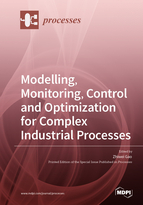Modelling, Monitoring, Control and Optimization for Complex Industrial Processes
A special issue of Processes (ISSN 2227-9717). This special issue belongs to the section "Process Control and Monitoring".
Deadline for manuscript submissions: closed (10 December 2022) | Viewed by 40332
Special Issue Editor
Interests: power conversion systems; machine learning; intelligent optimization; condition monitoring; tolerant control; wind turbine systems; offshore renewable energy; complex systems
Special Issues, Collections and Topics in MDPI journals
Special Issue Information
Dear Colleagues,
Industrial automation systems, such as chemical processes, manufacturing processes, power networks, transportation systems, sustainable energy systems, wireless sensor networks, robotic systems, and biomedical systems, are becoming more complex, but more expensive, and have higher requirements for operation performance, quality of products, productiveness, and reliability. Stimulated by Industry 4.0, automation industries are keen to improve the reliability and operational performance of complex industrial processes by using advanced modelling, monitoring, optimization and control techniques. Recently, artificial intelligence, data-driven techniques, cyber–physical systems, digital-twin, and cloud computation have further stimulated research and applications of modelling, monitoring, optimization and control techniques.
The Special Issue on "Modelling, Monitoring, Control and Optimization for Complex Industrial Processes " aims to provide a forum for researchers and engineers to report their recent results, exchange research ideas, and overlook emerging research and application directions in modelling, condition monitoring, optimization and advanced control for complex industrial processes.
Potential topics include, but are not limited to, the following:
- Complex dynamic analysis and modelling of industrial processes
- Data-driven modelling approaches for complex industrial processes
- Multiscale dynamic simulations of industrial processes
- Condition monitoring and fault diagnosis techniques
- Prognosis and predictive maintenance for complex industrial systems
- Advanced optimization methodologies
- Resilient control techniques
- Advanced approaches and techniques for cyber–physical systems
- Validation and real-time applications
Dr. Zhiwei Gao
Guest Editor
Manuscript Submission Information
Manuscripts should be submitted online at www.mdpi.com by registering and logging in to this website. Once you are registered, click here to go to the submission form. Manuscripts can be submitted until the deadline. All submissions that pass pre-check are peer-reviewed. Accepted papers will be published continuously in the journal (as soon as accepted) and will be listed together on the special issue website. Research articles, review articles as well as short communications are invited. For planned papers, a title and short abstract (about 100 words) can be sent to the Editorial Office for announcement on this website.
Submitted manuscripts should not have been published previously, nor be under consideration for publication elsewhere (except conference proceedings papers). All manuscripts are thoroughly refereed through a single-blind peer-review process. A guide for authors and other relevant information for submission of manuscripts is available on the Instructions for Authors page. Processes is an international peer-reviewed open access monthly journal published by MDPI.
Please visit the Instructions for Authors page before submitting a manuscript. The Article Processing Charge (APC) for publication in this open access journal is 2400 CHF (Swiss Francs). Submitted papers should be well formatted and use good English. Authors may use MDPI's English editing service prior to publication or during author revisions.
Keywords
- data-driven modeling and simulations
- advanced control
- intelligent optimization
- complex industrial processes
- dynamic analysis
- real-time validation and applications






